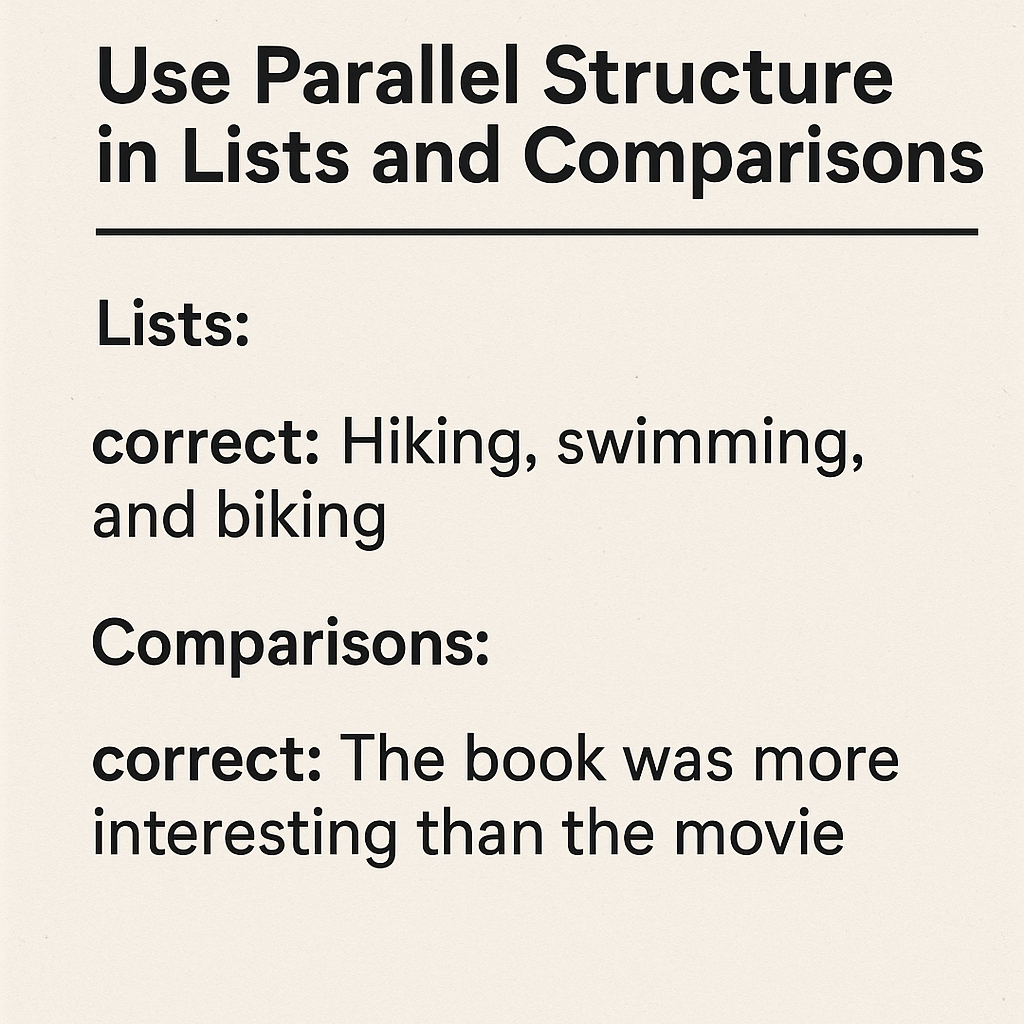Parallel Structure Rule-In Lists and Comparisons-Grammar Puzzle Solved-(43)
Parallel structure means matching grammatical forms in series, comparisons, or lists. Writers use it to improve flow and clarity. A lack of parallel structure can confuse readers. Here is an example:
- Wrong: She likes dancing, to swim, and biking.
- Right: She likes dancing, swimming, and biking.
Using the parallel structure rule ensures that each item in a list or comparison follows the same pattern. Writers coordinate items using the same word type and structure. This rule applies to verbs, nouns, adjectives, phrases, and clauses.
Why It Matters
Lists without parallel structure create jarring rhythm. Readers might stumble. Writing then feels choppy. A consistent format keeps writing smooth. It guides readers easily through ideas and adds professional polish. It shows writer’s control of language.
How to Apply
- Identify the form of the first item in your list.
- Make each subsequent item match that form exactly.
- Use commas or coordinating conjunctions (and, or) to connect items.
- Read the sentence aloud. It should sound rhythmic and balanced.
- Avoid mixing verb forms, noun phrases, or different clause types.
Types of Parallel Construction
A. Verb Form Lists
- Correct: She enjoys reading books, writing essays, and painting landscapes.
B. Noun Phrase Lists
- Correct: Our goals include innovation, collaboration, and sustainability.
C. Comparisons
- Wrong: He is more than just a friend. He offers advice, offers trust, and to listen.
- Right: He is more than just a friend. He offers advice, trust, and listening.
D. Paired Items
- Correct: He wanted either to learn a new skill or to improve an old one.
Common Errors with the Parallel Structure Rule
1. Mixing Verb and Noun Forms
This mistake happens when items in a list do not follow the same grammatical structure—specifically, when a verb form is used with a noun.
Incorrect:
- She likes hiking, to swim, and biking.
In this sentence:
- “hiking” (gerund)
- “to swim” (infinitive)
- “biking” (gerund)
This breaks parallel structure.
Correct:
- She likes hiking, swimming, and biking.
(All are gerunds: verb+ing)
Or:
- She likes to hike, to swim, and to bike.
(All are infinitives: to + verb)
2. Changing phrases into clauses mid-list.
Writers often begin a list with short phrases and end it with a full clause. This interrupts rhythm and clarity.
Incorrect:
- My goals are to travel the world, finding peace, and that I improve myself.
Here:
- “to travel the world” – infinitive phrase
- “finding peace” – gerund phrase
- “that I improve myself” – full clause
Correct:
- My goals are to travel the world, to find peace, and to improve myself.
(All are infinitive phrases)
Or:
- My goals are traveling the world, finding peace, and improving myself.
(All are gerund phrases) 3. Forgetting coordinating words for balance
Without connecting words like and, or, or but, a list becomes disjointed.
Incorrect:
- The team must review the plan, assign tasks, update everyone.
Here, the lack of a final conjunction (and) makes the list abrupt.
Correct:
- The team must review the plan, assign tasks, and update everyone.
Now the sentence flows smoothly with a complete, balanced list.
4. Creating comparisons that lack matching structure
When making comparisons, both sides of the comparison must follow the same structure.
Incorrect:
- He is more talented than how fast she runs.
Here, the first part is an adjective phrase (“more talented”), but the second is a clause (“how fast she runs”).
Correct:
- He is more talented than she is fast.
(Both are adjective phrases)
Or:
- He runs faster than she does.
(Both are comparative clauses)
Using parallel structure ensures clarity and rhythm. Errors in the parallel structure rule distract readers and weaken writing. However, by practicing these fixes, you can avoid these pitfalls and write more effectively.
Fixing Errors
- Locate nonparallel item.
- Rewrite item to match the first item’s form.
- Check for rhythm and clarity.
Example Revision
Wrong: The project requires planning, resource allocation, and you must lead meetings.
Right: The project requires planning, allocating resources, and leading meetings.
Using the parallel structure rule helps write sound, polished, and clear. Students, professionals, and writers all benefit. They avoid distractions that stem from structural mismatch.
Using this rule builds trust in your voice. It keeps readers focused on content. Use it in essays, reports, and creative work. Practice often. The parallel structure rule becomes second nature over time.

William Shakespeare as a Renaissance Writer:
https://englishlitnotes.com/2025/06/15/william-shakespeare-as-a-renaissance-writer/
Globalization’s Impact on Culture and Economy-Questions and Answers: https://englishwithnaeemullahbutt.com/2025/06/02/globalizations-impact-on-culture-and-economy/
The Prologue by Anne Bradstreet:
https://americanlit.englishlitnotes.com/the-prologue-by-anne-bradstreet/
Difference Between Have Tea, Take Tea, and Drink Tea: https://grammarpuzzlesolved.englishlitnotes.com/difference-between-have-tea-take-tea-drink-tea/
For grammar lessons, visit ChatGPT to explore the platform and interact with the AI: https://chat.openai.com
Discover more from Grammar Puzzle Solved by Naeem Ullah Butt
Subscribe to get the latest posts sent to your email.